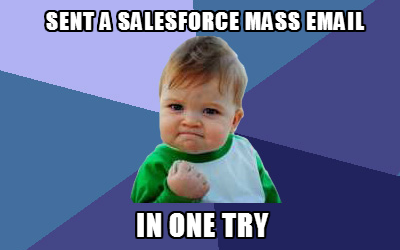What You Need to Know About Salesforce Mass Email – Limits and Options
With your lead and customer contact information conveniently stored in Salesforce it seems natural to consider utilizing Salesforce as a mass email application. The Salesforce mass email capabilities are built to leverage the CRM infrastructure of Salesforce and facilitate communications to your contacts.

The following are some tips on utilizing Salesforce mass email capabilities and also some interesting options that could make your email communications even easier.
You can create an email letterhead using Salesforce that can be reused for different communications. It can include your branding, logo, and emphasized messaging such as “TODAY’S SPECIAL MESSAGE.”
Salesforce has an email template capability to integrate your letterhead with mail merge fields. This makes your email more personalized. You can also create a full HTML email that does not need a letterhead.
Monitor activity on your emails through Salesforce allowing you to know what emails have been delivered and which ones were opened. This is an important metric to determine the effectiveness of your Salesforce mass email communications.
Salesforce mass emails do have some limitations, however. There is a maximum of 5,000 emails that can be sent within a 24 hour period. This maximum is only available if you have Salesforce Unlimited Edition. The Salesforce Professional, Enterprise, and Developer editions have mass email capabilities but have even smaller limits on the number of emails that can be sent. Also there is a maximum view size too of 250 for professional edition for example. So if you have a contact list of about 25,000 emails, you must divide up your list into small batches and send over several days to get around the view limits and the total daily limit. This may not be ideal for some customers where emails could have time sensitive sales or promotional information, or where productivity is concerned.
There are several steps to send Salesforce mass emails. Go to either the Leads or Contacts tab, choose mass emails under the Tools section, and use filters to create your email list. Next select the email template, review the number of emails to be delivered and whether you want the event posted as a completed activity. Choose a delivery option and hit send.
Third party mass email providers can complement your Salesforce email capabilities. Some have more elaborate tracking and monitoring features to allow you to know more about what happens to an email once it is delivered. For example you could know what links were clicked in the email.
One of the options available is the MassMailer tool which we created. No email limitations exist so you can send thousands of emails at once. User friendly tools allow you to create templates and letterheads easily. You can also schedule your mass emails to be sent at a specific date and time if you like. The reporting features of MassMailer lets you track the number of email opens, clicks, bounces, etc., to help you track your emails to determine what works best for your business.
As a bonus the number of steps to send an email is less with MassMailer than Salesforce, making the mass email process much more efficient. When it’s time to do your next Salesforce mass email, consider some new options to make your work much easier.
If you want to send Salesforce mass email with no limits and no headache, just check out MassMailer.
